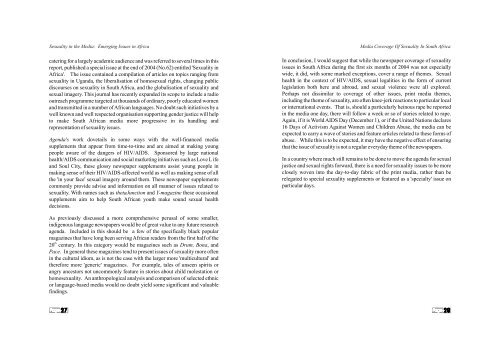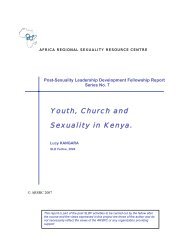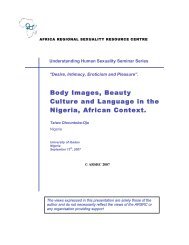Sexuality in Media: Emerging Issues in Africa - Africa Regional ...
Sexuality in Media: Emerging Issues in Africa - Africa Regional ...
Sexuality in Media: Emerging Issues in Africa - Africa Regional ...
You also want an ePaper? Increase the reach of your titles
YUMPU automatically turns print PDFs into web optimized ePapers that Google loves.
<strong>Sexuality</strong> <strong>in</strong> the <strong>Media</strong>: Emerg<strong>in</strong>g <strong>Issues</strong> <strong>in</strong> <strong>Africa</strong><br />
cater<strong>in</strong>g for a largely academic audience and was referred to several times <strong>in</strong> this<br />
report, published a special issue at the end of 2004 (No.62) entitled '<strong>Sexuality</strong> <strong>in</strong><br />
<strong>Africa</strong>'. The issue conta<strong>in</strong>ed a compilation of articles on topics rang<strong>in</strong>g from<br />
sexuality <strong>in</strong> Uganda, the liberalisation of homosexual rights, chang<strong>in</strong>g public<br />
discourses on sexuality <strong>in</strong> South <strong>Africa</strong>, and the globalisation of sexuality and<br />
sexual imagery. This journal has recently expanded its scope to <strong>in</strong>clude a radio<br />
outreach programme targeted at thousands of ord<strong>in</strong>ary, poorly educated women<br />
and transmitted <strong>in</strong> a number of <strong>Africa</strong>n languages. No doubt such <strong>in</strong>itiatives by a<br />
well known and well respected organisation support<strong>in</strong>g gender justice will help<br />
to make South <strong>Africa</strong>n media more progressive <strong>in</strong> its handl<strong>in</strong>g and<br />
representation of sexuality issues.<br />
Agenda's work dovetails <strong>in</strong> some ways with the well-f<strong>in</strong>anced media<br />
supplements that appear from time-to-time and are aimed at mak<strong>in</strong>g young<br />
people aware of the dangers of HIV/AIDS. Sponsored by large national<br />
health/AIDS communication and social market<strong>in</strong>g <strong>in</strong>itiatives such as Love L ife<br />
and Soul City, these glossy newspaper supplements assist young people <strong>in</strong><br />
mak<strong>in</strong>g sense of their HIV/AIDS-affected world as well as mak<strong>in</strong>g sense of all<br />
the '<strong>in</strong> your face' sexual imagery around them. These newspaper supplements<br />
commonly provide advise and <strong>in</strong>formation on all manner of issues related to<br />
sexuality. With names such as thetaJunction and Y-magaz<strong>in</strong>e these occasional<br />
supplements aim to help South <strong>Africa</strong>n youth make sound sexual health<br />
decisions.<br />
As previously discussed a more comprehensive perusal of some smaller,<br />
<strong>in</strong>digenous language newspapers would be of great value to any future research<br />
agenda. Included <strong>in</strong> this should be a few of the specifically black popular<br />
magaz<strong>in</strong>es that have long been serv<strong>in</strong>g <strong>Africa</strong>n readers from the first half of the<br />
th<br />
20 century. In this category would be magaz<strong>in</strong>es such as Drum, Bona, and<br />
Pace. In general these magaz<strong>in</strong>es tend to present issues of sexuality more often<br />
<strong>in</strong> the cultural idiom, as is not the case with the larger more 'multicultural' and<br />
therefore more 'generic' magaz<strong>in</strong>es. For example, tales of unseen spirits or<br />
angry ancestors not uncommonly feature <strong>in</strong> stories about child molestation or<br />
homosexuality. An anthropological analysis and comparison of selected ethnic<br />
or language-based media would no doubt yield some significant and valuable<br />
f<strong>in</strong>d<strong>in</strong>gs.<br />
<strong>Media</strong> Coverage Of <strong>Sexuality</strong> In South <strong>Africa</strong><br />
In conclusion, I would suggest that while the newspaper coverage of sexuality<br />
issues <strong>in</strong> South <strong>Africa</strong> dur<strong>in</strong>g the first six months of 2004 was not especially<br />
wide, it did, with some marked exceptions, cover a range of themes. Sexual<br />
health <strong>in</strong> the context of HIV/AIDS, sexual legalities <strong>in</strong> the form of current<br />
legislation both here and abroad, and sexual violence were all explored.<br />
Perhaps not dissimilar to coverage of other issues, pr<strong>in</strong>t media themes,<br />
<strong>in</strong>clud<strong>in</strong>g the theme of sexuality, are often knee-jerk reactions to particular local<br />
or <strong>in</strong>ternational events. That is, should a particularly he<strong>in</strong>ous rape be reported<br />
<strong>in</strong> the media one day, there will follow a week or so of stories related to rape.<br />
Aga<strong>in</strong>, if it is World AIDS Day (December 1), or if the United Nations declares<br />
16 Days of Activism Aga<strong>in</strong>st Women and Children Abuse, the media can be<br />
expected to carry a wave of stories and feature articles related to these forms of<br />
abuse. While this is to be expected, it may have the negative effect of ensur<strong>in</strong>g<br />
that the issue of sexuality is not a regular everyday theme of the newspapers.<br />
In a country where much still rema<strong>in</strong>s to be done to move the agenda for sexual<br />
justice and sexual rights forward, there is a need for sexuality issues to be more<br />
closely woven <strong>in</strong>to the day-to-day fabric of the pr<strong>in</strong>t media, rather than be<br />
relegated to special sexuality supplements or featured as a 'specialty' issue on<br />
particular days.






